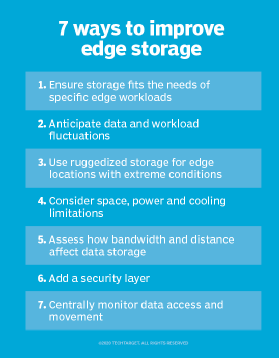storage at the edge
What is storage at the edge?
Storage at the edge is the collective methods and technologies that capture and retain digital information at the periphery of the network, as close to the originating source as possible.
In the early days of the internet, managing storage at the edge was primarily the concern of network administrators who had employees at remote and branch offices. By the turn of the century, the term was also being used to describe direct-attached storage in notebook computers and personal digital assistants used by field workers. Because employees did not always remember to back up storage at the edge manually, a primary concern was how to automate backups and keep the data secure.
Edge storage concerns
Today, as networked IoT devices generate more data, administrators who deal with storage at the edge are more concerned with establishing workarounds for limited or intermittent connectivity and dealing with raw data that might need to be archived indefinitely.

The prodigious volume of data coming from highway video surveillance cameras, for example, can easily overwhelm a traditional centralized storage model. This has led to experiments with pre-processing data at its source and centralizing storage for only a small part of the data.
An edge storage case study
In the case of automotive data, log files stored in the vehicle might simply be tagged so the data in question could be sent to the cloud for deeper analysis. In such a scenario, intermediary micro-data centers or high-performance fog computing servers could be installed at remote locations to replicate cloud services locally. This not only improves performance, but also allows connected devices to act upon perishable data in fractions of a second.
Depending upon the vendor and technical implementation, the intermediary storage location may be referred to by one of several names including IoT gateway, base station or hub.
Editor's note: This article was revised in 2023 by TechTarget editors to improve the reader experience.







